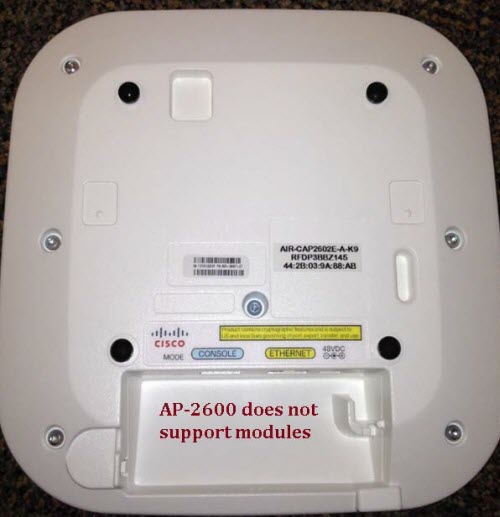The Cisco AP 3600 has a modular design that offers future protection with optional .11ac and security modules. The AP 2600 does not support optional modules. However, the Cisco AP 2600 does have a slightly higher antenna gain in the 2.4 GHz band.
The AP3600 and the AP2600 are the same size, but it is easy to identify each one by noting whether the Cisco logo has an embossed frame (AP 3600) or not (AP 2600).
Front View of the AP2600 and the AP 3600

The Cisco AP 2600 is a 3X4:3SS, so ClientLink does not beamform to 3SS clients; however, it does beam form at legacy, one, and two spatial stream rates. The AP 3600 is a 4X4:3SS, supporting an extra transmitter chain for additional down link performance for all bands and clients. The AP 3600 has slightly higher performance and beamforms to legacy, one, two, and three spatial stream rates and .11ac rates when using the optional .11ac module.
The two series use the same mounting hardware and antennas.
Back View of the AP 2600

Cisco 2600 Series AP vs. Cisco Aironet 3600 Series
Cisco Aironet 802.11n G2 Series Indoor Access Points | 2600 Series | 3600 Series |
Ideal for | Small, midsize, large enterprises and mid-market | Midsize or large enterprises |
Site type | Indoor office, medium-sized warehouse | Large office, midsize or large warehouse |
Application performance profile | Any Device/BYOD optimized | High client density |
Future-proof modularity | – | Yes |
Crowded areas | Yes | Yes |
Number of radios | Dual (2.4GHz and 5.0GHz) | Tri Radios |
Max data rate | 450 Mbps | 1.3 Gbps (with 802.11ac module) |
MIMO radio design: spatial streams | 3×4:3 | 802.11n: 4 x 4:3 |
Client count/ClientLink client count | 200/128 | 802.11n: 200/128 |
Autonomous access point option | Yes | Yes |
ClientLink 2.0 | Yes | Yes |
CleanAir | Yes | Yes |
VideoStream | Yes | Yes |
BandSelect | Yes | Yes |
Rogue access point detection | Yes | Yes |
Adaptive wireless intrusion protection system (wIPS) | Yes | Yes |
OfficeExtend | Yes | Yes |
FlexConnect | Yes | Yes |
Power | 802.3af, AC adapter | 802.11n: 802.3af, AC adapter |
Temperature range | 2600i: 0 to 40°C | 3600i: 0 to 40°C |
Antennas | 2600i: Internal | 3600i: Internal |
Wi-Fi standards | 802.11a/b/g/n | 802.11a/b/g/n/ac |
Government certifications | ||
Limited lifetime warranty | Yes | Yes |
*Planned for future support
More Related Cisco Access Point Topics:
How to Connect Cisco Wireless Access Point?
Types of Wireless Network & Wireless Topologies
Cisco Aironet 1600 Series AP Review
Cisco Aironet 1600/2600/3600 Series APs, Main Features and Comparison

